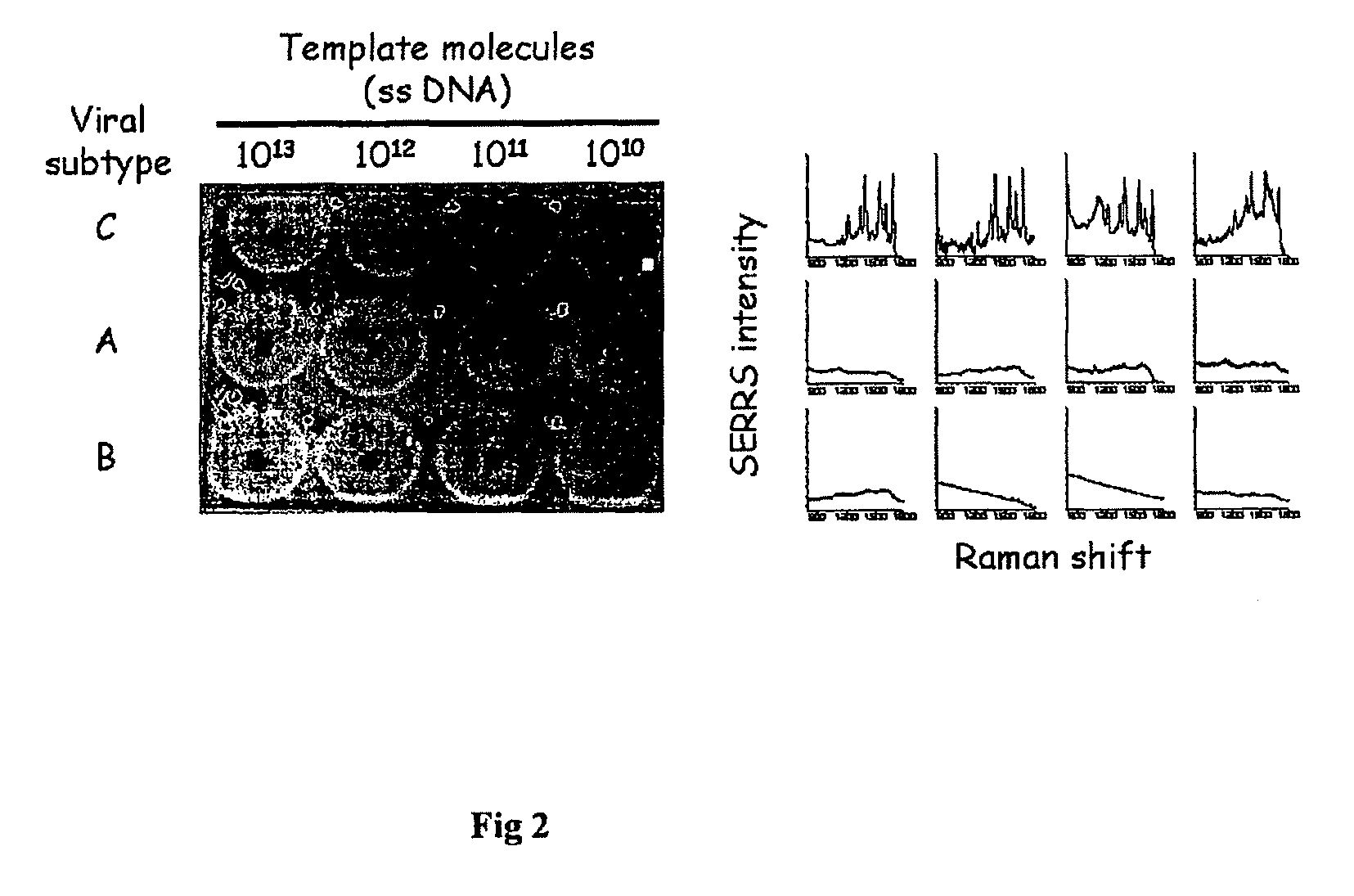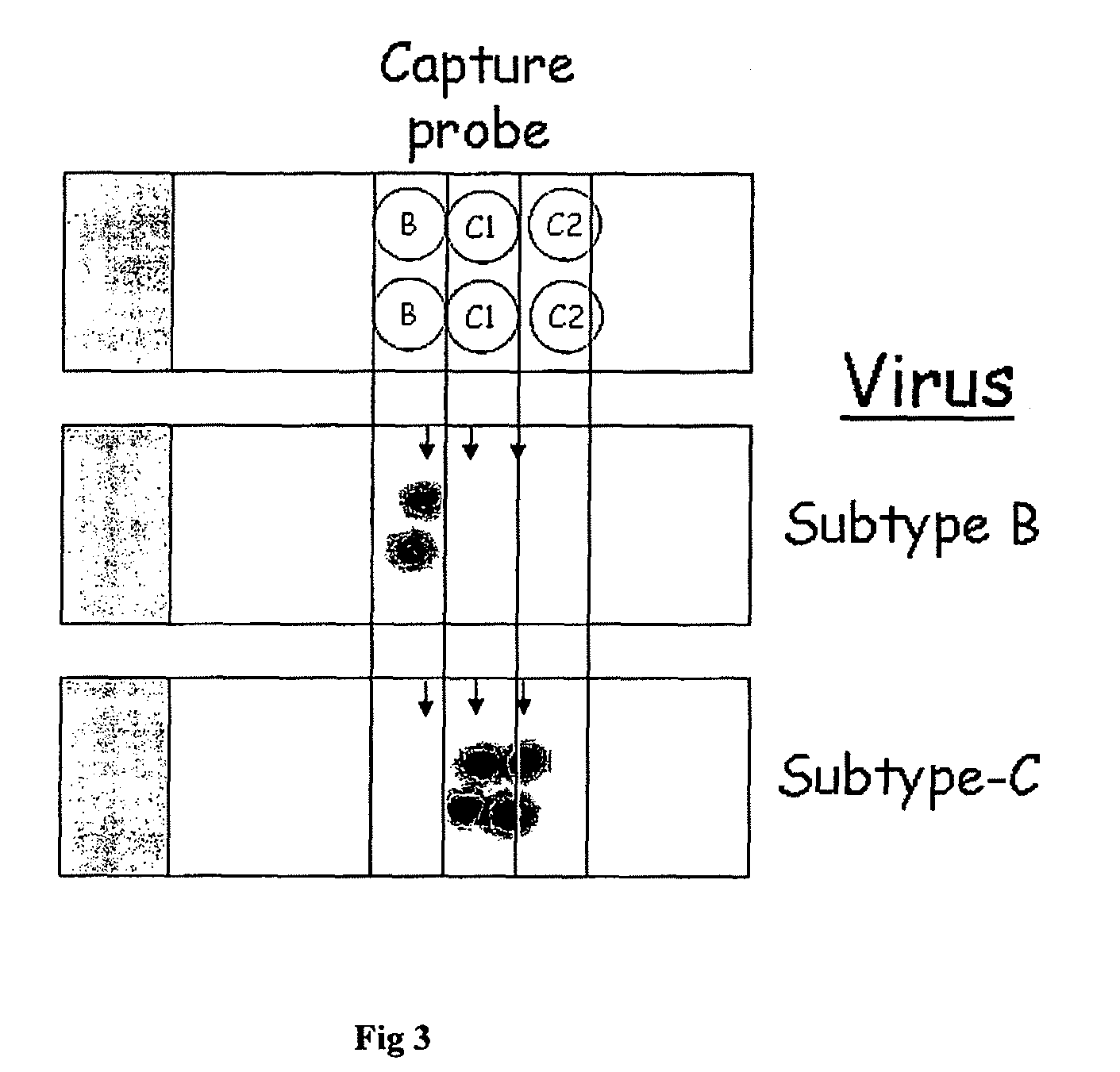High sensitivity assay for molecular typing of biological sample, probes and a kit thereof
a biological sample and high sensitivity technology, applied in the field of high sensitivity assay for molecular typing of biological samples, can solve the problems of false positive results, inability to apply to a large number of samples, and inability to avoid false positive results, etc., to achieve high sensitivity and avoid false positive/false negative results
- Summary
- Abstract
- Description
- Claims
- Application Information
AI Technical Summary
Benefits of technology
Problems solved by technology
Method used
Image
Examples
example 1
Preparation of the Target Viral Nucleic Acids for Capture
[0090]Experiments were conducted using full-length or partial segments of viral RNA or DNA, single-stranded or double-stranded. To make full-length viral RNA, plasmid DNA containing full-length viral sequences were transfected into HEK293 cells using standard calcium phosphate precipitation technique (Jordan M et al. (2004) Methods 33:136) Culture medium was collected at 72 h and saved in aliquots in a deep freezer. Concentration of the viral antigen p24 in the culture medium (viral stock) was determined using a commercial kit (Perkin Elmer Life Sciences, Boston, Mass., USA). Alternatively, tissue culture infection dose 50 (TCID50) titers of the viral stocks were determined in TZM-bl cells essentially as described (e.g. at the website available at hiv.lanl.gov / content / nab-reference-strains / html / Clade-C / TZM-b-1_Assay-SOP_January2007.pdf). Viral RNA was released from the viral particles by adding the detergent NP-40 to the stock...
example 2
Design and Synthesis of the Oligonucleotide Probes
[0091]The full-length HIV-1 sequences were down loaded from the Los Alamos database (available at hiv.lanl.gov / content / hiv-db / mainpage.html) and aligned using CLUSTAL X with minor manual adjustments (Thompson J D, Gibson T J, Plewniak F, Jeanmougin F, Higgins D G. The CLUSTAL_X windows interface: flexible strategies for multiple sequence alignment aided by quality analysis tools. Nucleic Acids Res 1997; 25 (24): 4876-4882). Regions that are highly conserved within a given viral subtype and deviated by at least one base pair from all other subtypes were identified by visual inspection. Oligonucleotides of 20-25 bp were designed using Oligo software version-6 to serve as capture or detector probes (available at oligo.net / ). Oligonucleotide synthesis along with chemical modification and fluorescent dye tagging has been ordered from a few commercial companies that offer custom services including AlphaDNA, MWG and Sigma-Aldrich.
example 3
Sequences of Probes Used in the Experiments
(All the Sequences from the Anti-Sense Strand)
[0092]
ProbeCommentSequence (5′-3′)CoordinateSEQ ID No. 41) Detector probe in U5-LTRAGTTACCAGAGTCACACAACAGACGG564-589(N707)2) Identifies all subtypesHXB23) Modifications a) None b) Cy-5 (19649) c) R6G d) Thiol and Cy-5 (19648)SEQ ID No. 11) Subtype-B capture probeCCAGTCCCGCCCAGGCCACG381-400(N729b)2) Amino-modified at N-termHXB23) Spanning the Sp1 sitesSEQ ID No. 21) Subtype-C capture probeACCTCCTGGAACGCCCCAGT363-382(N730c)2) Amino-modified at N-termIndie3) Located spanning the C-kBSEQ ID No. 31) Subtype-C capture probeTCAGATCTGGTCTACCTAGAGAGAC456-480(N731c)2) Amino-modified at N-termIndie3) Located in ‘R’ of LTR
PUM
| Property | Measurement | Unit |
|---|---|---|
| nucleic acid | aaaaa | aaaaa |
| surface-enhanced scattering | aaaaa | aaaaa |
| SERS | aaaaa | aaaaa |
Abstract
Description
Claims
Application Information
 Login to View More
Login to View More - R&D
- Intellectual Property
- Life Sciences
- Materials
- Tech Scout
- Unparalleled Data Quality
- Higher Quality Content
- 60% Fewer Hallucinations
Browse by: Latest US Patents, China's latest patents, Technical Efficacy Thesaurus, Application Domain, Technology Topic, Popular Technical Reports.
© 2025 PatSnap. All rights reserved.Legal|Privacy policy|Modern Slavery Act Transparency Statement|Sitemap|About US| Contact US: help@patsnap.com



